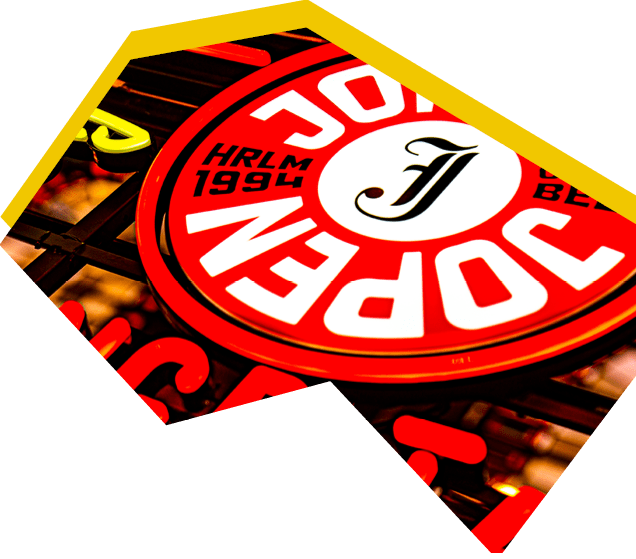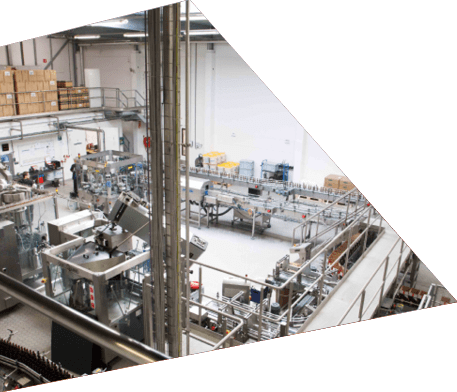
We had a chat with Michel from Jopen
We had an open conversation with Jopen. With founder Michel Ordeman: about the origin, the craft beer world today and beers. Including the newest collab with Van Moll: Smash My Hops Up!
Since 1501
We know Jopen as one of the oldest craft beer breweries in the Netherlands, but how did Jopen start? Michel begins with his story ‘In 1992, in honor of the city’s 750th anniversary, the city of Haarlem requested ideas for this festive year. There were many reactions to this, including an old-fashioned joust with knights on horseback with lances. Also, brewing a beer, according to an old traditional recipe, emerged by different people because of the strong brewing past. As a city, Haarlem could not release beer, but they did bring these people together in the form of a foundation. At one of the early meetings, one of the members, who owns a beer shop, referred to a student who was working on a graduate thesis on brewpubs. That was me.’
Inspecting brouwerskeuren
‘We then started looking for something tangible in the brewing history of Haarlem. We found ‘brouwerskeuren’ brewers’ labels, a kind of Reinheitsgebot, from 1407 and 1501. We had them translated from old Dutch. We took the recipes to the beer brewing faculty of the University of Leuven, who brewed it on a trial basis. In the end we chose the Hoppenbier from 1501. We couldn’t brew the beers without a brewery, so I enlisted the help of Chris Wisse, who was then brewing at the Halve Maan (now the Vermeersen brewery). The beer was originally only brewed for the festive year, but I got the taste of it’.
And there was Jopen. ‘Well no. I thought if we gave the city a present, it would be a shame if you take that present away again. A number of people from the foundation agreed on this, but many did not have the ambition to become a brewer. I got their blessing to continue. “Just do it” as it were. We initially wanted to go for a historic brewery name, but we didn’t want to “favor” a brewery, so we looked for something more general. That was ‘Jopen’, as they called the 112 liter beer kegs back then.’
Belgisch bier uit Nederland
Toen begon Jopen te lopen…‘We zagen de opkomst van speciaalbieren, althans Belgische traditionele bieren. Ander speciaalbier kende men toen nog niet. Toen we voor het eerst op pad gingen naar cafés en slijterijen kregen we vaak de vraag wat voor bier het was? “Een bovengistend meergranen bier, 6,8% blond.” “Ah, het is dus Belgisch bier?” “Eh ja, maar dan wel uit Nederland.” “Dus je hebt een Belgisch bier nagebrouwen?” “Nee, het is een traditioneel Haarlems bier”. Ze geloofden het gewoon niet, in Nederland brouwen we alleen pils…dat was de perceptie.’
Belgian beer from the Netherlands
Then Jopen started to skyrocket… ‘We saw the rise of craft beers, at least Belgian traditional beers. At that time, no other craft beer was known. When we first went to pubs and liquor stores we were often asked what beer it was? “A top-fermented multigrain beer, 6.8% blonde.” “Ah, so it’s Belgian beer?” “Um yes, but from the Netherlands.” “So you’ve brewed a Belgian beer?” “No, it is a traditional beer from Haarlem”. They just didn’t believe it, in the Netherlands we only brew lager… that was the perception.’
‘Besides Jopen, there were few other breweries at that time.’t IJ, Christoffel and Oudaen to name a few… except there was no Dutch craft beer for sale in the supermarkets. And that has been our goal, almost from the beginning, we wanted to make it easier for the craft beer drinker. Sometimes we would get back from a liquor store “I don’t like the fact that you are in the supermarket”. We’d answer that with the counter question “Oke, but will you stop with Duvel and Hoegaarden tomorrow too?” We are not concerned with excluding anyone, but rather with offering a wide range. The craft beers such as barrel aged, limited editions and collabs are often not available in the supermarkets.’
“And a three-grain beer, with oats in it, was not common in those days. It was no longer brewed in Belgium either. We really did something new and different, but with a historical base. We said to ourselves, if we continue and develop new beers, we also want to continue to give that unique interpretation. That if someone buys the beer, they don’t buy it because it comes from Haarlem, but because it is special and distinctive.’
Respect for roots
They retain that distinction at Jopen, although you do not immediately see it in bizarre combinations. ‘We still brew the Hoppenbier according to the original recipe, but we have switched with the hops. We always choose European hops because of the local and historical aspect. We also started brewing American hops a few years later, when they were on the rise in terms of availability. Although we are always looking for new flavours, surprising ideas and special combinations. Like distinctive grains, for example. In 2018 we adopted a Dutch hop field and we also work together with a micromaltery in the Haarlemmermeer. This way we brew beers with a local touch. LaLaLager is brewed with spelt malt from the Haarlemmermeer. And later this year we are going to brew another Fresh Hop beer collab with Moersleutel with hops from our own hop field.’
So no crazy flavors or brews out of Jopen’s kettles? “We released a beer smoked on sheep shit. Icelandic style, because they have no trees there, so they smoke on sheep shit.
Pretty special if you ask me. Or our Spanish Inquisition, a beer with Madame Jeanette peppers, very tasty. Although each batch is slightly different in terms of strength. We also once brewed a bock beer with 400 kilos of mashed figs. Very tasty with the smell and taste of fig and a hint of coconut, but also very expensive. People ask us if we are going to brew it again, but we underestimated this beer in terms of price. It became three times as expensive as a normal bock. And if it says bock on it, people don’t expect such a high price. You can do that with a stout or a sour. In addition, we try to use other grains more; think of our “Viva el Rye” (100% rye IPA) that is released annually in April and the “Don’t tRYE this @home” (a Barley Wine with 70% rye).
Learning from the wine lover
Then we get to talking about the prices of beers these days. ‘I see more and more beers where the costs exceed ten euros and that these are bought still. The beer drinker also matures. Basically as a wine drinker knows; I can buy a bottle of wine for one and a half euros or one for three thousand euros. Only they don’t say ‘that’s ridiculous’, no they just accept that they are a different kind of wine drinker. It is even more difficult for the beer drinker. A beer can contain very expensive ingredients, have been in expensive barrels or beer can be lost due to a large dry hopping…this all affects the price. We just have to get the beer drinker, who thinks a ten-euro can is ridiculous, to say “this isn’t beer for me”. That people will see it as normal, that there are also beers in a higher price segment.”
‘I am also pleased to see that, partly due to the supermarket product range, the group of craft beer drinkers is growing. The share of craft beer has grown in the last 5 years from 8 to more than 12%, so a growth of 50%, I think it’s a good development. The offer is increased, it increases the ease of purchase, everyone benefits from that. Let’s not forget, we’re talking about craft beer here. And did you know that the craft beer share is 12.1%, of which only 2% is craft beer? The other 10% is from the large concerns. So there is plenty of room to grow. In America 15% of the market is craft beer, which is more than seven times as much. If we want fun, good breweries to continue to exist, craft beer has to be available everywhere.”
De ‘gevestigde orde’ tegen nieuw geweld
Niet alleen de speciaalbierdrinkersgroep blijft groeien, er komen ook steeds meer brouwerijen bij. ‘Ik vind het heel goed, als bierliefhebber en -drinker denk ik alleen maar ‘yes!’. Die ruimte is er, hoewel het merendeel hiervan onder de 1000 hectoliter zit. Het is natuurlijk niet zo dat er een stortvloed van bier op de markt is gekomen. Vaak zijn de craft beer brouwers zeer regionaal of juist lokaal en dat is alleen maar goed! Het nadeel hiervan is dat wij, en andere collega brouwers, bijna in het rijtje geplaatst worden van de andere grote brouwerijen, terwijl wij ook craft beer brouwers zijn. We zijn dan wel een van de oudjes, maar we zijn wel jong van geest. We worden misschien wat weinig gevraagd voor festivals. Als ik dan vraag waarom dan krijg ik vaak terug “jullie zijn al zo groot”. Zo groot? Ja, we zijn misschien een van de grotere craft bier brouwerijen in Nederland, maar op Europees niveau stellen we weinig voor. We krijgen zelfs wel eens van collega brouwers terug dat ze maar weinig van onze bieren kennen. We brouwen veel meer, maar dat beseft niet iedereen. We zijn veel meer dan het rijtje van vijf bieren in de supermarkt.’
The ‘established order’ against newbies
Not only does the craft beer drinker group continue to grow, more and more breweries are emerging. ‘I think it’s very good, as a beer lover and drinker my only thought is ‘yes!’
There is plenty of room for them, although most of the breweries brew under 1000 hectolitres. It’s not the case that a flood of beer has hit the market. Often the craft beer brewers are very regional or local and that is only a good thing! The disadvantage of this is that we, and other fellow brewers, are almost placed on the same scale as the other large breweries, whilst also being craft beer brewers. We may be old, but we are young at heart. We are not asked to join a festivals as much. When I ask why, I often get back “you are already so big”. So big? Yes, we may be one of the larger craft beer breweries in the Netherlands, but on a European level we are just peanuts. We even get feedback from fellow brewers that they know very little about our beers. We brew a lot more, but not everyone realizes that. We are much more than
Smash My Hops Up…
Fortunately, you were invited to Van Moll Fest. “Yes, we’ve been there before. It is a super fun festival, the location is unique, the range of breweries is top notch and there is a relaxed atmosphere. So when we were asked to join again, we immediately went to see if we could do a collab and present it at the festival. We went for a smash beer (Single Malt and Single Hop), then we went to see what kind of malt became the base of the brew. A pilsner malt or a pale ale malt was possible, but we chose something else. Erwin and I were in Liverpool a few years ago for a brewers conference, where we tasted a heritage malt, a pale ale malt from an old grain variety. Unfortunately, it was not available on time, so we went to look further…in the Netherlands. In the east of the country there is a micro maltery Masterveld, they malt regionally grown barley into “region malt” that has become the malt. A distinctive malt, a local product, a beautiful story. We brewed a Pale Ale-like beer, very drinkable, 5.3% and well hopped with Czech Cardinal hop. This hop was supplied by Hollands Hophuis, who challenge several brewers to brew a SMASH beer. And it’s going to be called ‘Smash My Hops Up’, a little nod to The Prodigy.”
Smash My Hops Up can be ordered from today in our bar!





